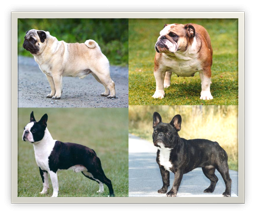Many of the articles in this section of DogWellNet.com on The Brachycephalic Issue focus on challenges and efforts at breed club, kennel club, national and international levels and across diverse stakeholder groups - breeders, breeding advisors, veterinarians, researchers, regulators and others. Many visitors to this site will be well-acquainted with the physical, physiological and welfare issues in individual dogs and for breed populations. In this article, we point to some resources that are available describing the problems that can arise because of the brachycephalic conformation. There are many articles online - below we highlight a few that have useful information and a variety of approaches.
Carol Beuchat, PhD, from The Institute of Canine Biology, has written an excellent and comprehensive coverage of how the conformation of the brachycephalic affects physiological processes and health. In her article Brachycephaly: it's more than just the pretty face she provides a detailed, comprehensive and technical description of the impact of a shortened skull in dogs.
One example of a simple lay description of the issues in brachycephalics is found under DOGS WITH SPECIAL FACES. This website and this information is provided by a veterinary clinic in L.A., in the USA. This material is provided to educate their clients about the the physical and physiological differences in brachycephalic dogs ('breeds with "pushed in" faces' , to quote them) that owners must bear in mind. The material covers the respiratory system, breathing problems and heat stroke; eye problems; skin problems; and issues with their teeth. This veterinary clinic is just one of many who have put together educational material for brachycephalic dogs.

An important quote from this veterinary clinic is:
"Altogether, the brachycephalic breeds show plenty of personality and intelligence just as all dogs do but because of their special needs, they require some extra knowledge of their owners."
Regardless of the ongoing, recent and future focus on these breeds or what changes might be made to the breeding of brachycephalics, there are currently many thousands of these dogs in almost every country of the world. There is a range in conformation within and across breeds; there is a range is the existence of the Brachycephalic Obstructive Airway Syndrome within and across these breeds; there is undoubtedly a range in prevalence and severity of health and welfare impacts. But it is clear that dogs of these breeds are at increased risk for various problems and educating owners that they have a 'special needs dog' might be helpful.
Many breed clubs for brachycephalics provide similar information on concerns that must be considered in these dogs. For example, The ABC of a Happy & Healthy Pug is an information sheet provided by the Pug Dog Club, in the UK. In it they say 'There is no excuse for an overweight pug! A balanced diet, regular exercise and avoiding titbits will help to keep every pug slim, fit and healthy!' All information sheets for brachys caution about the risk of heat stress in these dogs (the functional reasons behind that is clearly explained in the Beuchat article, above).
However, perhaps these cautions are not strong enough. It may be that many owners do not realize that, the extent to which they will need to provide extra care - or at least be extra vigilant - for a flat-faced dog. Well-educated and experienced pug owners, e.g., will keep their dog slim and relatively fit and accommodate an aging pug with an exercise program that adapts to its needs. Do new owners acquiring these dogs - perhaps due to appeal, esthetics and popularity - realize that there are special challenges and added responsibilities?
Although every veterinarian will say that no dog, of any breed, should be obese, overweight brachycephalics may experience life-threatening consequences. In some of the recent studies, researchers have noted that the function of these dogs may be even more susceptible to impairment due to obesity or a lack of fitness, (e.g. Finland Pug Study and Rowena Packer's study described in The Brachycephalic Issue: Evidence and Efforts).
Other articles in this series will look at numbers and percentages of affected dogs within and across breeds and continue to assemble information on evidence and efforts to improve health, well-being and welfare.
 Donate
Donate

Recommended Comments
There are no comments to display.
Join the conversation
You can post now and register later. If you have an account, sign in now to post with your account.
Note: Your post will require moderator approval before it will be visible.